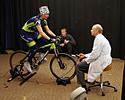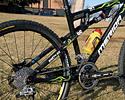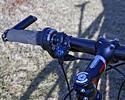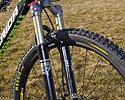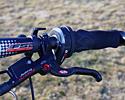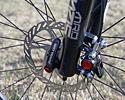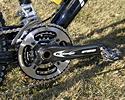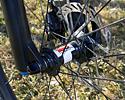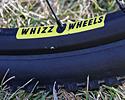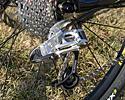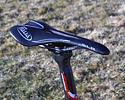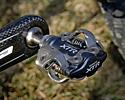
Recently on Cyclingnews.com |
Pro bikes, January 16, 2008
Gunn-Rita Dahle FlesjŚ's Multivan-Merida Merida Ninety-Six
A new weapon in the quiver for the seven-time world championBy James Huang When all is said and done, Norway's Gunn-Rita Dahle FlesjŚ may just go down as the most dominant female mountain biker in history. With the exception of two poor seasons attributed to severe overtraining, the 34 year-old has been a constant and overshadowing presence at the sport's uppermost level almost immediately since turning professional in 1996 with two World Cup wins and a fourth-place finish at the Olympic games in Atlanta. Since 2002, she has also earned seven sets of UCI world championship stripes (four in cross-country, three in marathon) and has won the European title six times (five cross-country, one marathon). In spite of the success, though, the Norwegian remains surprisingly unassuming, is eminently approachable and personable, and has managed to retain her love of the sport. Many have wondered about the secret to that nearly unrelenting mass of success, but Dahle FlesjŚ insists that there is no such secret; just focused determination, a meticulous attention to detail, and lots of good old fashioned elbow grease on behalf of herself and her husband and trainer, Kenneth FlesjŚ. "I probably have some talents for the sportÖ I don't know," she said. "I started with mountain biking and just came out of nowhere more or less, and I felt I was one with the bike from one of the first days. So maybe it's a little bit of talent, but it's mainly passion and hard work in my opinion. At least since Kenneth and I started working together as athlete and trainer in 2002, it all comes down to that you do every day more or less perfect, as close to 100% as possible. There has to be a good plan, of course, but you can have in that plan three hours of long training today, and you have intervals tomorrow. But if you feel that you'd rather do two because you want to have the most of tomorrow also, you also have to do this adjustment." 2003 marked the first time Dahle FlesjŚ visited Dr. Andy Pruitt, bicycle fitter extraordinaire at the Boulder Center for Sports Medicine. Dahle FlesjŚ's early career coach was primarily a road racer, and had thus set her up in a decidedly road bike-like position ill suited for off-road riding. Pruitt implemented a wide-sweeping range of adjustments, including handlebar and saddle positions and careful canting of her feet to achieve proper knee tracking and power output, and has also assisted the seven-time world champion with her pedaling technique. "It's hard to tell if I've become seven-time world champion [as a result since] I won the worlds and the European [championship] also in 2002 before I met Andy," she said on the effects of Pruitt's services. "Of course, the sport is kind of becoming more and more professional in every aspect. So working with Andy has given me some percent for sure. And just the confidence in working with AndyÖ we have more or less been visiting every year now for the last five or six seasons and it's just the confidence that you can show that, yeah, you can still improve but you are already strong. And you can look at where you can improve and work with that the rest of the year. So it's not only the millimeter here or centimeter there, but you also find that it comes to the technique, not only with the setup of the bike." "For sure, after she was at his place in 2003, I could feel a lot of difference on how her muscles worked," added Kenneth FlesjŚ. "Because before she had not such a good recovery. Her handlebars were 6cm lower before. I think if she didn't change her position in 2003, her career would be much shorter." Another key to her success may also lie in the stability of her sponsorship arrangement. Taiwanese bike mega-manufacturer Merida has supported Dahle FlesjŚ since her comeback in 2002, and the pair has flourished together since then. "She's won all of her titles on Merida," said Kenneth Flesja. "That makes it really special, because they [Merida and Gunn-Rita] have a history of support together. The budget now is huge. So we were really lucky. They gave us a contract and we've just built on that. Now Gunn-Rita has a great contract, and I think she will continue to ride Merida for the rest of her life. There are not that many riders that have their name so connected to their bike brand. On the mountain bike especially, it's very important to build up a long-term relationship. In Norway, if you were to ask a girl or guy on the street which brand Gunn-Rita uses, they would say 'Merida'; they are so connected. All the dealers in all the different countries are really behind the team supporting it. All of the dealers give one dollar for each bike they sell to the budget of the team. So it's like a big family. That's also special." Dahle FlesjŚ has raced on a hardtail throughout her career but will finally add a full-suspension model to her arsenal this season, Merida's brand-new Ninety-Six. Previously debuted as the 'Beijing', the new Ninety-Six offers (surprise) 96mm of rear wheel travel in a svelte carbon fiber package that is claimed to weigh under 1.9kg (4.2lb), complete with its DT Swiss XR Carbon rear shock and remote lockout lever. The carbon main frame and rear triangle employ a mix of monocoque and tube-to-tube construction techniques using pre-compressed prepreg sheets and Merida's own 'Nano-Matrix' resin, which the company says improves impact resistance by 40% over standard resins. The rear suspension uses a simple single-pivot architecture for stiffness and durability and includes a short top tube-mounted rocker link to drive the shock. That link was still made from CNC machined aluminum on Dahle FlesjŚ's bike when we caught up with her during a training camp in Boulder, Colorado, but Merida ultimately plans on using a carbon piece. In spite of the frame's relatively short travel, Merida saw fit to equip the Ninety-Six with a low leverage ratio (said to be in the neighborhood of sub-2:1) that keeps operating pressures low and improves the suspension's ability to react to terrain changes. In this particular case, Dahle FlesjŚ's machine was fitted with a slightly shorter-stroke shock (but with the same eye-to-eye length) that maintained the frame geometry but decreases travel slightly to a more race-appropriate 88mm. According to Merida research and development head Juergen Falke, however, light weight was but one of several prime objectives. Bottom bracket and front triangle stiffness were of paramount importance as well, and Merida claims a substantial 25% advantage in stiffness-to-weight ratio over its next best competitor in the lightweight XC segment. Carefully engineered fiber layup schedules and tube shapes obviously play their usual role here, but the Ninety-Six top- and down tubes also house a now-patented surprise. Much like FSA does with its top-end K-Force Light carbon crankarms, the Ninety-Six sports a vertically oriented rib in those spans that bisects both tubes from wall to wall, thus forming two separate chambers. Both of those additional hidden frame members serve to greatly increase the overall frame stiffness. Falke says that the top tube rib also serves to distribute transmitted shock loads over a larger area. "At the down tube, the vertical rib improves the bending strength of the chassis against forces initiated through the fork, [especially] during hard front wheel braking and causes as well higher head tube stiffness," he said. "As additional benefit, the hit resistance of the down tube's bottom side [from objects thrown up by the front wheel] is still quite reasonable, even [though] the carbon wall thickness of the down tube bottom is very small." Just as in years past, Dahle FlesjŚ's bike continues to wear a healthy dose of FSA componentry, including the carbon fiber seatpost, crankset, ceramic bearing bottom bracket, handlebars, and aluminum stem. In addition to the rear shock, the DT Swiss label is also found on the 190 Ceramic Center Lock disc brake hubs and Aerolite spokes (the Norwegian star's bike was also equipped with DT Swiss aluminum rims as well, although they wore the decals of Taiwanese rim manufacturer Alex). The rest of the build was filled out with SRAM's X.0 twist shifters, X.0 and X-9 derailleurs, PC-991 chain, and PG-990 cassette, Avid Juicy Ultimate disc brakes, Maxxis rubber, and a Selle Italia saddle. Manitou continues on as Dahle FlesjŚ's fork sponsor and equips her with its new 80mm-travel R-Seven MRD model that is reportedly fully stock with the exception of some additional crown machining. Interesting, Dahle FlesjŚ continues to champion Shimano SPD pedals, in this case from the latest generation XTR group. According to Kenneth FlesjŚ, "Gunn-Rita has been getting a lot of [sponsorship] offers, but she feels that Shimano gives her a safer feel and they are bigger. She doesn't want to mess around with other pedals." Chiming in from across the room, Dahle FlesjŚ added, "I feel my feet going over like that [makes a 'c' shape with her hand] and I get so cramped!" Merida was careful to mimic the geometry of its carbon hardtail when designing the Ninety-Six, but Dahle FlesjŚ still must put in some valuable time in getting used to her new rig. Surprisingly, the seasoned veteran has never raced on a full-suspension machine, and admits that she's barely even ridden one for any appreciable length of time. "I don't think I'm going to switch [completely]," she said. "I probably have the chance now to choose, depending on the course, and that's a great benefit in my opinion. I just have to get used to the riding style. And if I feel comfortable on that, then of course, I can probably ride faster on the really technical courses than if I only had the hardtail to choose." After a rough summer in 2007, Dahle FlesjŚ looks optimistically and excitedly towards the coming season with a new bike at her side and an unwavering support structure. "We really got the bad taste of that this summer when you couldn't be on the bike because of your health was not good," she said. "So then you really got to tell yourself, 'This is why I am mountain biking because it is so fun.' And we'll never forget that again after what we went through last summer. There are so many people expecting this and pressuring that and you have do thisÖ you feel that it's crazy. It's still great to win but you forget the heart of it. It's not about winning. It's the passion for what we are doing. That's what it comes down to, the center of the thing with mountain biking. If I can just come back, ok, even if I don't win a single race next season. No one will believe me, but just if I feel good and my health is normal, I'm happy! If you don't have the enjoyment and passion about it, it's hard to be the top in the world, that's for sure." And what of her long-term plans? Racers hoping that Dahle FlesjŚ would soon hang up her cleats clearly have a long wait ahead of them. "I hope I will race even when I am seventy!" she continued. "But as a professional, I will look towards the Olympics in London. So that means at least five more seasons. And I hope my body can handle it! I just have to take good care of it. But the spirit, the joy about mountain biking is higher and feels better than probably ever." What should the world think of a well-trained, highly disciplined, well-prepared, highly motivated, and newly equipped Gunn-Rita? Let's just say we're happy to be on this side of the course tape. Watch out, 2008. PhotographyFor a thumbnail gallery of these images, click here Images by James Huang/Cyclingnews.com
| |||||
Full specificationFrame: Merida Ninety-Six, 88-96mm travel Critical measurements Bottom bracket: FSA Ceramic MegaExo |
Rims: DT Swiss XR 4.1 Bars: FSA K-Force XC, 520mm Pedals: Shimano XTR PD-M970 Total bike weight: 9.9kg (targeted 9.0kg weight with complete race equipment) | ||||




